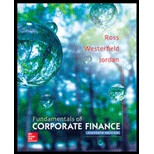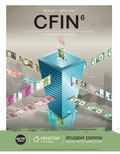
a)
To determine: The market value of the capital structure.
a)
Answer to Problem 16QP
The market value of the capital structure is $484,220,000.
Explanation of Solution
Given information:
Company T has an outstanding bond issue. The bond has a face value of $1,000 and a coupon rate of 6.5 percent. The company issued 120,000 bonds. The bonds mature in 15 years and make semiannual coupon payments. The bonds sell at 107 percent of the face value in the market.
It has 7,300,000 common equity shares outstanding. The market price of the share is $46. The stock has a beta of 0.95. The company has also issued preferred stock. There are 220,000 outstanding preference shares. The dividend per share is 4.5 percent and its current market value is $91 per share. The market risk premium is 7 percent, and the risk-free rate is 3.6 percent. The tax rate applicable is 35 percent.
The formula to calculate the market value of equity:
The formula to calculate the market value of preferred stock:
The formula to calculate the market value of debt:
The formula to calculate the total market value of the capital structure:
Compute the market value of equity:
Hence, the market value of equity is $335,800,000.
Compute the market value of preferred stock:
Hence, the market value of preferred stock is $20,020,000.
Compute the market value of debt:
Hence, the market value of debt is $128,400,000.
The formula to calculate the total market value of the capital structure:
Hence, the total market value of the capital structure is $484,220,000.
b)
To determine: The discount rate.
Introduction:
The weighted average cost of capital (WACC) refers to the weighted average of the cost of debt after taxes and the
b)
Answer to Problem 16QP
The weighted average cost of capital is 8.31 percent. It is the return based on the risk of the firm. If the proposed project has a risk similar to that of the firm, then it can use the weighted average cost of capital as the discount rate.
Explanation of Solution
Given information:
Company T has an outstanding bond issue. The bond has a face value of $1,000 and a coupon rate of 6.5 percent. The company issued 120,000 bonds. The bonds mature in 15 years and make semiannual coupon payments. The bonds sell at 107 percent of the face value in the market.
It has 7,300,000 common equity shares outstanding. The market price of the share is $46. The stock has a beta of 0.95. The company has also issued preferred stock. There are 220,000 outstanding preference shares. The dividend per share is 4.5 percent and its current market value is $91 per share. The market risk premium is 7 percent, and the risk-free rate is 3.6 percent. The tax rate applicable is 35 percent.
The formula to calculate annual coupon payment:
The formula to calculate the current price:
The formula to calculate the yield to maturity:
Where,
“C” refers to the coupon paid per period
“F” refers to the face value paid at maturity
“r” refers to the yield to maturity
“t” refers to the periods to maturity
The formula to calculate the cost of equity under the Security market line (SML) approach:
Where,
“RE” refers to the expected
“Rf” refers to the risk-free rate
“RM” refers to the expected return on the market portfolio
“(RM−Rf)” refers to the market risk premium
“βE” refers to the beta or risk of the equity
The formula to calculate the cost of preferred stock:
Where,
“RP” refers to the return on preferred stock or cost of preferred stock
“D” refers to the dividend earned on the preferred stock
“P0” refers to the current price of preference stock
The formula to calculate the weighted average cost of capital:
Where,
“WACC” refers to the weighted average cost of capital
“RE” refers to the return on equity
“RP” refers to the return on preferred equity
“RD” refers to the return on debt
“E” refers to the amount of common equity capital
“P” refers to the amount of preferred equity
“D” refers to the amount of debt
“V” refers to the total amount of capital
“TC” refers to the corporate tax rate
Compute the annual coupon payment:
Hence, the annual coupon payment is $65.
Compute the current price of the bond:
The face value of the bond is $1,000. The bond value is 107% of the face value of the bond.
Hence, the current price of the bond is $1,070.
Compute the semiannual yield to maturity of the bond as follows:
The bond pays the coupons semiannually. The annual coupon payment is $65. However, the bondholder will receive the same is two equal installments. Hence, semiannual coupon payment or the 6-month coupon payment is $32.5
The remaining time to maturity is 15 years. As the coupon payment is semiannual, the semiannual periods to maturity are 30
Finding “r” in Equation (1) would give the semiannual yield to maturity. However, it is difficult to simplify the above the equation. Hence, the only method to solve for “r” is the trial and error method.
The first step in trial and error method is to identify the discount rate that needs to be used. The bond sells at a premium in the market if the market rates (Yield to maturity) are lower than the coupon rate. Similarly, the bond sells at a discount if the market rate (Yield to maturity) is greater than the coupon rate.
In the given information, the bond sells at a premium because the market value of the bond is higher than its face value. Hence, substitute “r” with a rate that is lower than the coupon rate until one obtains the bond value close to $1,070.
The coupon rate of 6.5 percent is an annual rate. The semiannual coupon rate is 3.25 percent
The attempt under the trial and error method using 2.9 percent as “r”:
The current price of the bond is $1,069.50 when “r” is 2.9 percent. This value is close to the bond value of $1,070. Hence, 2.9 percent is the semiannual yield to maturity.
Compute the annual yield to maturity:
Hence, the yield to maturity is 5.8 percent.
Compute the cost of equity:
Hence, the cost of equity is 10.25 percent.
Compute the cost of preferred stock:
Assume that the face value of one preferred stock is $100. At 4.5 percent, the dividend on preferred stock is $4.5
Hence, the cost of preferred stock is 4.95 percent.
Compute the weighted average cost of capital:
Hence, the weighted average cost of capital is 8.31 percent.
Want to see more full solutions like this?
Chapter 14 Solutions
Fundamentals of Corporate Finance
- Mr. Siya, the Chief Financial officer at WXZY Limited has noticed an increase in the company's stock returns variation over the last two financial years. He is interested in understanding the underlying influences on the company's stock returns. You have been tasked to perform a linear regression to understand whether the company's profit margins (independent variable) impact its stock returns. You have been provided with data for both the company's average monthly stock returns and profit margins over a 6-month period in 2022. Month July August September October November December Profit margins (x) Stock returns (y) 0.0263 0.0618 0.0389 0.1156 0.0158 0.0534 0.0461 0.1610 0.0030 0.0395 0.0393 0.1031 a) Calculate both the slope coefficient of the regression. b) Calculate the intercept of the regression. c) Calculate the unexplained/unexpected variation of the regression. d) Calculate the coefficient of determination. 6000 (2) (5) (3)arrow_forwardDo not answer wit incorrect values i will unhelpful!arrow_forwardWhat are the implications of missing a credit card payment in finance?arrow_forward
- Omni Advisors, an international pension fund manager, uses the concepts of purchasing power parity (PPP) and the International Fisher Effect (IFE) to forecast spot exchange rates. Omni gathers the financial information as follows: Base price level 100 Current U.S. price level 105 Current South African price level 111 Base rand spot exchange rate $ 0.188 Current rand spot exchange rate $ 0.171 Expected annual U.S. inflation 7% Expected annual South African inflation 5% Expected U.S. one-year interest rate 10% Expected South African one-year interest rate 8% Required: a. The current ZAR spot rate in USD that would have been forecast by PPP.Note: Do not round intermediate calculations. Round your answer to 4 decimal places. b. Using the IFE, the expected ZAR spot rate in USD one year from now.Note: Do not round intermediate calculations. Round your answer to 4 decimal places. c. Using PPP, the expected ZAR spot rate in USD four years from now.Note: Do not round intermediate calculations.…arrow_forwardDelta Company, a U.S. MNC, is contemplating making a foreign capital expenditure in South Africa. The initial cost of the project is ZAR11,000. The annual cash flows over the five-year economic life of the project in ZAR are estimated to be 3,300, 4,300, 5,290, 6,280, and 7,250. The parent firm's cost of capital in dollars is 9,5 percent. Long-run inflation is forecasted to be 3 percent per annum in the United States and 7 percent in South Africa. The current spot foreign exchange rate is ZAR per USD = 3.75. Required:. Calculating the NPV in ZAR using the ZAR equivalent cost of capital according to the Fisher effect and then converting to USD at the current spot rate. - NPV in USD using fisher effect Converting all cash flows from ZAR to USD at purchasing power parity forecasted exchange rates and then calculating the NPV at the dollar cost of capital. - NPV in USD using PPP rates Are the two USD NPs different or the same? What is the NPV in dollars if the actual pattern of ZAR per…arrow_forwardWhat is the 50/30/20 budgeting rule in finance?arrow_forward
 Intermediate Financial Management (MindTap Course...FinanceISBN:9781337395083Author:Eugene F. Brigham, Phillip R. DavesPublisher:Cengage Learning
Intermediate Financial Management (MindTap Course...FinanceISBN:9781337395083Author:Eugene F. Brigham, Phillip R. DavesPublisher:Cengage Learning Financial Accounting: The Impact on Decision Make...AccountingISBN:9781305654174Author:Gary A. Porter, Curtis L. NortonPublisher:Cengage Learning
Financial Accounting: The Impact on Decision Make...AccountingISBN:9781305654174Author:Gary A. Porter, Curtis L. NortonPublisher:Cengage Learning

 EBK CONTEMPORARY FINANCIAL MANAGEMENTFinanceISBN:9781337514835Author:MOYERPublisher:CENGAGE LEARNING - CONSIGNMENT
EBK CONTEMPORARY FINANCIAL MANAGEMENTFinanceISBN:9781337514835Author:MOYERPublisher:CENGAGE LEARNING - CONSIGNMENT





